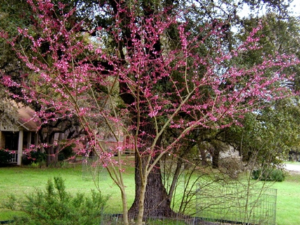Author: Bill Ward
This year Operation NICE! (Natives Instead of the Common Exotics!) will be reintroducing ten of the native plants that proved over the years to be among the most successful and favorite landscape plants… 10 for ’10. What follows is modified from a February, 2003 column.

Operation NICE! is recommending Texas redbud (Cercis canadensis var. texensis) for the February native plant of the month. It ought to be an easy sell. Everybody welcomes the early-spring blossoms of the redbud. They are one of the first signs that winter is on the way out.
If the redbuds are blooming, can the bluebonnets be far behind?
Texas redbud is a multi-trunked small tree or large shrub that grows on the thin limestone soils of the Hill Country. It is popular as a landscape plant because of its profuse clusters of tiny rose-pink blooms.
In an ideal year when spring comes on slowly, every limb of the redbud is covered with the bright flowers before the leaves sprout. That is when the tree is most attractive and when it may linger in bloom for two or three weeks or more. Warmer spring weather seems to rush the bloom period and encourage leaf growth, which somewhat diminishes the effect of the blooms. Even then, they are pretty trees.
Some years, an unusually late and frigid cold snap will nip the buds of the early bloomers among our redbuds. However, from what I have noticed in this part of the Hill Country, most years the Texas redbud is not as likely as the Texas mountain laurel to have its flowers destroyed by late freezes.
Blooms aside, Texas redbud is a handsome landscape tree. From spring into fall its many branches are abundantly covered by glossy deep-green heart-shaped leaves a few inches across. In the fall, the leaves turn yellow for a few weeks before they are shed. After the leaves fall, the bloom buds are already big enough that one can predict many weeks ahead of time how a tree will blossom in the spring.

Texas red buds are easy to grow in our alkaline soil and can thrive in part shade to full sun. Along the road we drive to Boerne, redbuds thrive and bloom profusely as small understory trees in dappled shade. Once established, Texas redbuds survive with little extra watering. We water redbuds in our yard only during periods of severe drought. This species of redbud probably will not do so well in poorly drained areas.
The Texas redbud has a couple of cousins, one from East Texas and one from the Trans Pecos, which also are grown in this area. The eastern redbud (C. canadensis var. canadensis) is widespread over the eastern half of the US. It tends to have a single main trunk and fairly rapidly can grow to be a large tree, even in our alkaline soils. Still, I think the smaller Texas redbud has deeper-colored blossoms and nicer foliage than the eastern variety, and it demands less water.
The drought-tolerant Mexican redbud (C. canadensis var. mexicana) is a multi-trunked tree with glossy leaves a little smaller than those of the Texas redbud. There is a great deal of overlap in the ranges of the three redbud varieties. Natural hybrids may confuse recognition of redbuds in the wild. Apparently a number of cultivars are available in the nursery trade, further confusing identification.
In our neighborhood, redbuds of any variety, especially the young ones, need to be protected from deer. Perhaps I keep protective fences around my small trees longer than I need to, because I’ve noticed that some neighbors were able to remove protection when their redbuds reached 8 or 10 feet high and foliage was trimmed too high for the deer to reach. Texas redbud, however, commonly grows with low branches, and the trunks are just the right diameter for bucks to rub. I think I’ll keep my fences in place for the time being.
The Boerne Chapter of the Native Plant Society of Texas provides free planting and care instructions for Texas redbud at nurseries participating in Operation NICE! (Hill Country African Violets and Nursery, Maldonado Landscape and Nursery, and Medina Garden Nursery) and at Cibolo Nature Center.


